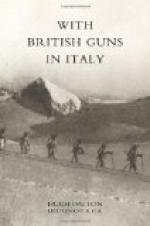She entered the war nine months after the British Empire, but her losses, when the war ended, had been proportionately heavier than ours. According to the latest published information the total of Italian dead was 460,000 out of a population of 35 millions. The total of British dead for the whole British Empire, including Dominion, Colonial and Indian troops, was 670,000, and for the United Kingdom alone 500,000. The white population of the British Empire is 62 millions and of the United Kingdom 46 millions. Thus the Italian dead amount to more than 13 for every thousand of the population, and the British, whether calculated for the United Kingdom alone or for the whole white population of the Empire, to less than 11 for every thousand of the population. The long series of Battles of the Isonzo,—the journalists counted up to twelve of them in the first twenty-seven months in which Italy was at war,—the succession of offensives “from Tolmino to the sea,” which were only dimly realised in England and France, cost Italy the flower of her youth. The Italian Army was continually on the offensive during those months against the strongest natural defences to be found in any of the theatres of war. On countless occasions Italian heroes went forth on forlorn hopes to scale and capture impossible precipices, and sometimes they succeeded. Through that bloody series of offensives the Italians slowly but steadily gained ground, and drew ever nearer to Trento and Trieste. Only those who went out to the Italian Front before Caporetto, and saw with their own eyes what the Italian Army had accomplished on the Carso and among the Julian Alps, can fully realise the greatness of the Italian effort.
It must never be forgotten that Italy is both the youngest and the poorest of the Great Powers of Europe. Barely half a century has passed since United Italy was born, and the political and economic difficulties of her national childhood were enormous. For many years, as one of her own historians says, she was “not a state, but only the outward appearance of a state.” Her natural resources are poor and limited. She possesses neither coal nor iron, and is still partially dependent on imported food and foreign shipping. She is still very poor in accumulated capital, and the burden of her taxation is very heavy.
From the moment of her entry into the war her economic problems became very difficult, especially that of the provision of guns and munitions in sufficient quantities, and the extent to which she solved this last problem is deserving of the greatest admiration. Her position grew even more difficult in 1917. After the military collapse of Russia she had to face practically the whole Austrian Army, instead of only a part of it, and a greatly increased weight of guns. The Austrians had 53 millions of population to draw from, the Italians only 35. Moreover, just before Caporetto, a number of German Divisions, with a powerful




